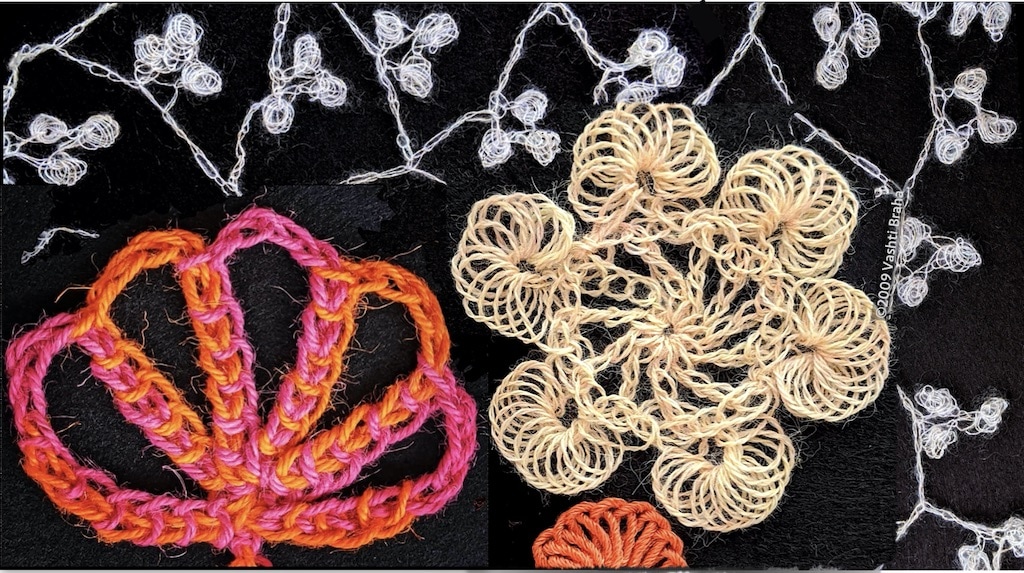
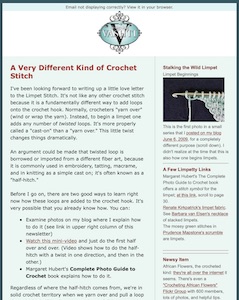
Updates October 20, 2020: I expanded the Timeline entries for 1977, 1982, and 1991.
The limpet stitch crochet topic evolved dramatically in the ten years since I wrote my third newsletter about it. As of September 4, 2020, this greatly updated version is now my ultimate resource page for crocheting limpets, limpet variations, and more reasons to crochet with half hitches. It even has a timeline and a table of related terms.
“Limpets, those cheery, little-used sideways shells.”
Sue Perez (a.k.a. Mrs. Micawber)
Issue #003 went out to just over 370 subscribers in 2010. That’s about 70 more than for issue #002. I remember feeling very encouraged by that. One of my early goals was to find likeminded crocheters. Back then, the only folks talking (enthusiastically!) about the limpet stitch, like Mel, Myra, Barbara, Margaret, and Pippin, were members of FFCrochet, the International Freeform Guild (INTFF) yahoo group. Limpet stitches have expanded their reach, as you’ll see below.
From the Archives: A Very Different Kind of Crochet Stitch
Vashti’s Crochet Inspirations Newsletter, Issue #3 (First Published September 30, 2010)
I’ve been looking forward to writing up a little love letter to the Limpet Stitch. It’s not like any other crochet stitch because it is a fundamentally different way to add loops onto the crochet hook. (September 2010)
The first thing a crocheter learns, after making a slip knot and putting the loop on a crochet hook, is to yarn over (wind or wrap the yarn around the crochet hook). We can’t make any basic stitches without it. Strictly speaking there’s only one way to do it. If you wind the yarn around your hook the opposite direction, it’s a yarn under. (Read all about yarn overs, yarn unders, and reasons to use both.)
There are other ways to add new loops to the crochet hook beside yarning over (or under). The one we use for limpet stitch crochet is challenging at first only because changing how you yarn over feels very alien! It’s actually simple, easy, and quick to do. The limpet stitch has an avid fan club.
Beyond the Standard Yarn Over
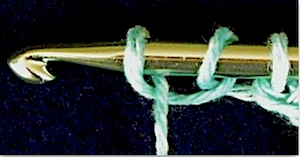
From a crocheter’s point of view, limpet stitch yarn overs have an added half-twist in them. In the photo at right you can see how the two loose loops on the hook have a little twist at the bottom of them. Adding the half-twist as you yarn over is a neat trick.
This simple little twist is powerful. It is the basis of all needle lace, macramé, and tatting. It’s fundamental to sewing and embroidery. Latch hook rug making requires it, and bobbin lace starts with it. It’s the simplest cast on in knitting.
Making room for it in our crochet toolbox means reclaiming the DNA that crochet shares with these other string arts. You may wish to make room for two more, like I have. The little half-twist can turn in two different directions: to the left (counterclockwise), or to the right (clockwise). The two loops in the photo turn to the left, as if a cursive letter “e” is written backwards: “ɘ”.
Two Kinds of Half Hitches
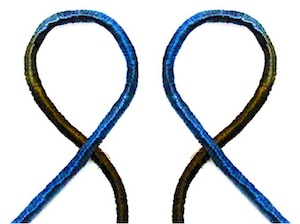
The basic difference between the two half hitches–it either turns to the left or the right– is a building block for stitches, textures, and other effects.
What does this mean for crochet? We only need one kind of half hitch to crochet limpet stitches. Some crocheters naturally favor one, and some the other, as you’ll see.
It’s great to know how to do both at some point. You can get the full range of features and limpet variations by mixing the two kinds.
About the Name
What shall we crocheters call it? I’ve been calling it (my default left-turning one) a half hitch since I started designing with it in 2009; Marty Miller, who was my technical editor, suggested it based on Myra Wood’s and Angela Grabowski’s use of the term. Sooner or later I’ll need a way to refer to the two kinds individually, though. Perhaps left hitch and right hitch…
Sue Perez, who has been producing several limpet-related discoveries, patterns, and videos, calls the two kinds forward loop and backward loop (more on that below). Researcher Cary Karp says it’s most widely known as simple looping, but it would likely be confusing for crocheters.
Below is a table of names used for this stitch, depending on the fiber technique. Perhaps you’re already familiar with it.
| Technique | Half-twist counterclockwise/to the left (ɘ) | Half-twist clockwise/to the right (e) | Pair of same twist | Pair of different twists | A whole twist or more |
|---|---|---|---|---|---|
| Knitting (CO means “Cast On”) | Backward-Loop CO, Simple CO, Single CO, Half-Hitch CO, Twisted-Loop CO, Knit-Loop CO, Thread-Over-The-Thumb CO, Right-Slanting-Loop CO | Simple CO, Simple Looped CO, Single CO, Purl Loop CO, E-Wrap CO, Left-Slanting Loop CO | n/a | Alternate-Loop CO | Twisted-Loop CO, Elastic CO, Twisted Simple CO, Czech Variation, Double Twist Variation |
| Macramé & Knot Tying | Half Hitch (tied to the left) | Half Hitch, Double Half Hitch or Clove Hitch (tied to the right) | Double Half Hitch, Clove Hitch | Lark’s Head Knot, Reverse Double Half Hitch | |
| Tatting | (One loop is a half of) Double Knot Stitch or Double Stitch | (One loop is a half of) Double Knot Stitch or Double Stitch | Double Knot Stitch, Double Stitch, Lark’s Head. | ||
| Hand Sewing, Embroidery | Blanket Stitch, Buttonhole Stitch | Blanket Stitch, Buttonhole Stitch | n/a | n/a | Knotted Blanket Stitch, Knotted Double Cast On Stitch |
| Needle Laces | Buttonhole Stitch | Buttonhole Stitch | n/a | n/a | Spanish Point |
Half Hitches With a Crochet Hook
Back in 2010 I was able to find only a few knitting how-to videos showing how to add these loops to the crochet hook. In fact, one that I linked to in the newsletter is still one I recommend. It’s at Knitting Help and shows a half hitch being added to a knitting needle over and over. This is how I add them to my crochet hook, and I’ve really picked up speed making them by now. There are many methods. Here’s a recent example: Sheep & Stitch’s Easy Cast On for Beginners.
As of 2013, I can link to half hitch how-to videos by and for crocheters. Watch how Sue Perez adds what she calls the Forward Loop to her crochet hook: a half-twist turn to the right like the letter “e“. She finishes by demonstrating limpets with them. The right-turning loop is Sue’s favorite, instead of the left one that I’m accustomed to.
Try them both and see which feels natural to you. Sue wrote to me, “The only difference, I think, between Forward Loops and Backward Loops is that Forward Loops flow more smoothly onto the hook – they take advantage of the natural direction of the working yarn over the forefinger.”
Watch Linda Dean add left-turning “ɘ” loops to her crochet hook and then go on to demonstrate nestled limpets!
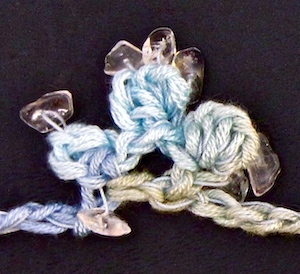
A Limpet Violet from the Trailing Vine Lariat pattern 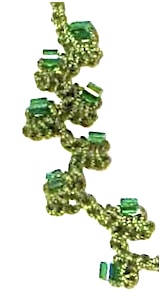
From the 2010 issue: beaded limpet swatch in size 20 thread 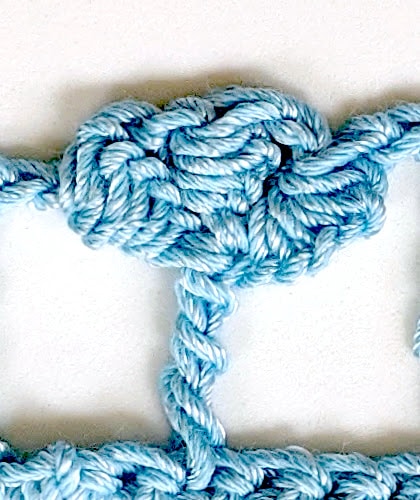
2020 swatch: a limpet tree!
Limpet Stitch Crochet Steps
Limpets are much easier to make than they look. They are simple clusters of half hitches that magically fan out into a unique shell shape. In the two crochet videos just mentioned, Sue’s limpets had 3 loops, Linda’s had 5. In my limpets at the top of this post, each of the 6 big limpets around the rim have 15 half hitches. I used a 10 mm crochet hook size to make the loops so open. You can make limpets of any number of loops you wish; 6 or 7 is probably typical. The more half hitches you add to your hook, the more it can fan out into a shell shape.
When you have the number of loops you want on your hook, just yarn over normally and pull through all of the half hitches at once. I pinch them to make it easier to pull the loop through them all. Margaret Hubert suggests making the half hitches over the thumb rest part of the hook to make them a bit looser.
Why did nobody tell me about this sooner? It’s just as exciting as the bullion, but 10 times easier!
Teresa O.
Now have a look at an important page from Margaret Hubert’s Complete Photo Guide to Crochet book. You’ll see a swatch and pattern for limpets all over the surface of a simple crochet background—complete with a limpet stitch symbol.
Little Frills of Wonder
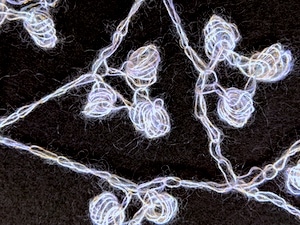
There is a lot to love about limpets and other half hitch stitches. For one thing, they seem to resist crushing. I found this swatch balled up in storage from when I crocheted it in 2011! The chain stitches are more crumpled than the limpets.
Limpets blossom in looser gauges and a range of yarns. You see more of their delicate internal space, and there’s room for many more half hitches in the cluster. I’ve seen others remark on this too: limpet stitches look more delicate than they are. The twist in each loop somehow locks the strand in place and adds stability.
An advantage to using Limpets for flower petals is that, in contrast with more familiar kinds of stitch clusters, they are less dense and round. Limpets are lighter-weight puffs and uniquely flattened, like pillows or oyster shells.
From my 2011 Trailing Vine Lariat pattern
Limpets vs. Other Bobbles
I often see limpet stitches described as an easier type of bullion stitch (a.k.a. roll stitch), and as a “shell”. I think structurally they have more in common with bobbles, such as half double puff stitches and other clusters that stand out from the surrounding stitches. Some bobbles and clusters are crocheted into on the next row. Others aren’t and so they dangle freely.
Limpets tend not to have stitches crocheted into them. They lack the typical top loops that define most crochet stitches.
Here’s a comparison of bobbles, crocheted with a big hook and thin mohair so that you can see most of their individual loops. The photo exaggerates some things and leaves out others, so I hope you’ll try swatching your own comparison. The first on the left looks more appealing in the photo than my impression while crocheting it; it feels heavy and dense. The next one looks flatter than it is. It’s plump, like a pillow or a closed clam shell. It surprises me that the third from the left looks messy in the photo! And the farthest right one looks flat. It’s actually the most bubble-like of them all.
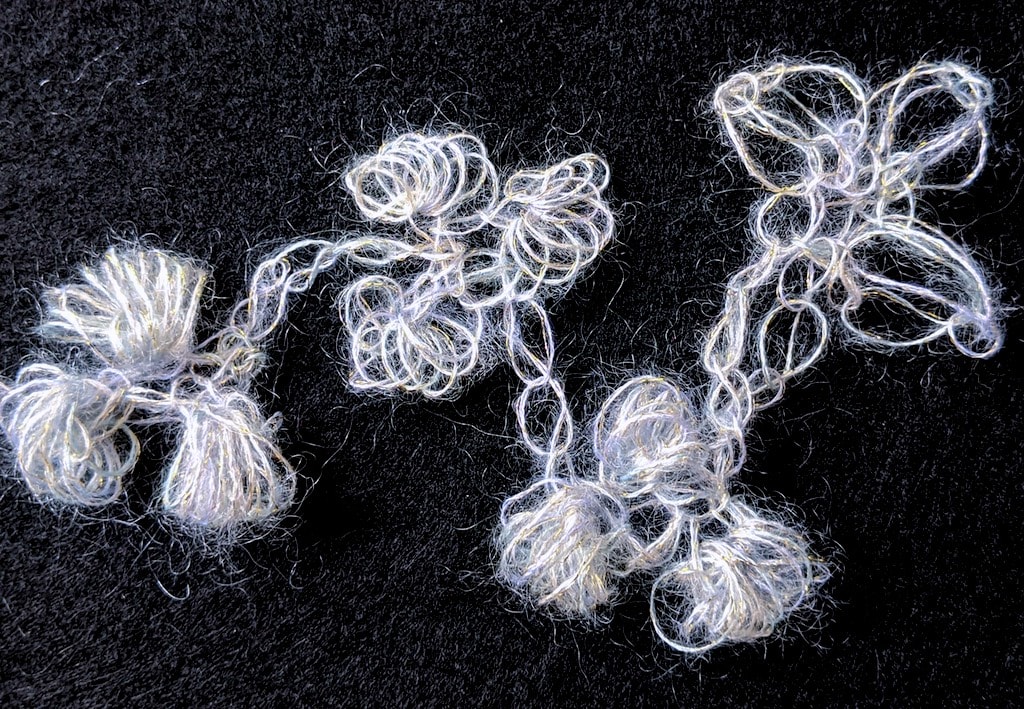
Practical Uses
Limpet stitches are beloved as decorative flourishes, but they’re also problem solvers. Even just one half hitch comes in very handy. Use them to increase any number of stitches at the end of a row of regular crochet, and especially at the slightly fiddly end of a Tunisian forward pass.
We can use it as a type of foundation stitch, instead of chains, like Sue Perez does. Sue also discovered that a half hitch here and there improved her Yarnberries design: “A note on the Forward Loop Chain: You may be wondering, why the special stitch? Why not just chain 1 between Berries? The Forward Loop Chain is more stable, keeps the Berry string from twisting, and also makes it easier to identify the back loop of the 1st chain which is right above it.”
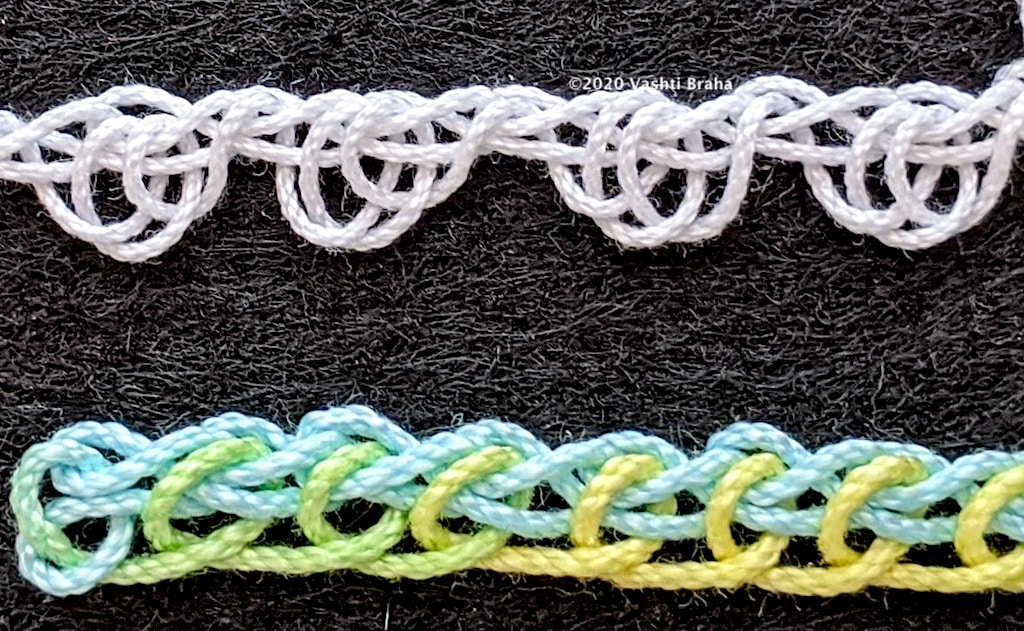
Compare it with the lotus shape pictured at the top of this post.
Limpet Stitch Crochet FAQ
Not exclusively. It is crocheted the same whether you add it to a Tunisian or regular (non-Tunisian) crochet project. There seems to be some confusion about whether the Limpet is a Tunisian stitch. ARNie (Angela Grabowski) describes the limpet as a popcorn variant for Tunisian crochet that she found in a Victorian book, but this just demonstrates how versatile and valuable this stitch is to know.
Yes. For limpet stitch crochet, each yarn over needs to have a half twist in it to start. It’s easy, and only seems challenging at first because changing something as basic as how you yarn over feels very alien. In knitting, the yarn over you use is called a simple cast on (it goes by many more names).
Have other questions? I’ll add them here with their answers.
Sidebar Items
Until issue #96, every newsletter followed the same format. A sidebar along the right of the main topic contained three things: highlights and asides for the main article, DesigningVashti News (later sometimes DV News or In the DV Shop), and Newsy Item, which later became Favorite Links or Links of the Week.
DesigningVashti News
The big news in issue 3 was two new patterns:
I’m poised on the very brink of adding 2 new patterns! They’re being professionally tech edited now. One of my policies is to never rush my tech editor :) How about sneak peeks?
About five months before, Interweave Crochet published my Five Peaks Shawl. I used paired half hitches (limpets, basically) along the end of every Tunisian forward as a problem-solving increase method. Its springy edge matches the stretch and texture of the starting edge of the rows nicely. Some crocheters found it challenging, so I developed the Four Peaks Scarf: one less peak and a different increase method.

Waterlily Layer 3-in-1 first announced in Issue #3 
Frostyflakes Wrap first announced in Issue #3 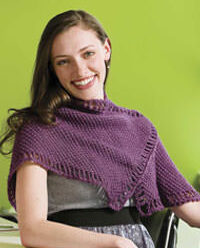
L-shaped Five Peaks Shawl, Interweave Crochet Magazine 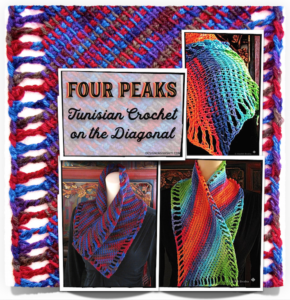
Four Peaks Scarf: a rectangular Five Peaks.
“Frostyflakes is a corner-start, any yarn amount, edge-as-you-go-and-call-it-a-day kind of pattern. Made this white silk one first, and lace weight cashmere one that looks frosty. Then made a beaded red one and now I can’t stop thinking of holly! It’s thrilling to be able to write patterns for a range of yarn weights. I didn’t get a chance to when I freelanced for other publishers.”
Newsy Item
In later issues I often called it “Favorite Links” or “Links of the Week” and it sometimes had three or more items. I was still trying it out for this early issue, so I mentioned just one. I include now as a flashback to 2010 crochet culture:
African Flowers, the crocheted kind: they’re all over the internet it seems. There’s even a “Crocheting African Flowers” Flickr Group with 600 members, lots of photos, and helpful tips. Here’s Heidi’s howto for this pretty motif.
Remember seeing African flowers in social media and on blogs? Flickr groups have not been very active since 2015 or so.
This brings me to the close of my love letter, and yet another thing I love about Limpets: how stable the strands are. This is an important quality when you use big hooks. The half hitches sort of lock the strands into place and give the Limpet an internal integrity. In other words, Limpets look more delicate than they are.
September 2010
Limpet Stitch Crochet: A Timeline!
Circa 1900: Angela Grabowski and Helen Free both mention limpets used with Tunisian Crochet in a Victorian source. I’ll add it here when I find its title.
1977
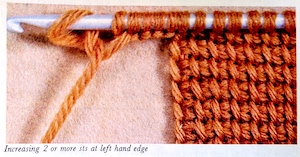
Golden Hands Special #40 (London, UK: Marshall Cavendish Publications Ltd, first published in 1975), page 29. Under an image of a Tunisian crochet hook with several half hitches on it at the end of a forward pass is the caption, “Increasing 2 or more sts at left hand edge”. It’s rare to see half hitches recommended as an increase method. The image shows a loose half hitch just added to the hook, but it has an extra twist in it. It’s a full twist, not a half-twist. (Also, the explanation on the facing page describes a different kind of increase, not the one in the photo.)
1982
The Complete Stitch Directory by Patsy North (NY, USA: Crescent Books). Angela Grabowski notes in her Encyclopedia of Tunisian Crochet (see 2004 below) on page 20 that the half hitch is a way to increase stitches at the end of a forward pass in this book. I’ve confirmed this with the 1989 edition of Patsy North’s book. On page 121 it’s the only method shown for increasing more than one stitch at the end of a row: “Work to end of a forward row, then make extra stitches by forming a loop in the yarn, twisting it to place it on the hook.” The drawing of these loops show a full twist, not a half twist and matches the photo in the 1977 Golden Hands Special #40 shown above.
1990’s
1991: Tricot Crochet by Rebecca Jones. Half hitches occur in two places:

image above showing a loop with a whole twist.
- The Limpet Shell Stitch is explained on page 49 following the Bullion Stitch, and has two images: an antique etching of a limpet stitch in progress within a swatch of Tunisian Simple Stitch (TSS), and a close up of a swatch. “This Victorian stitch is quite unusual, as the little round clusters of loops sit right out from the fabric…” and then Weldon’s is mentioned for having a tea cozy featuring this stitch.
- Page 25: individual half hitches as a way to increase several stitches at the end of a Tunisian forward row. The drawing illustrates the same full-twist type (see image above for the 1977 book) instead of a half-twist.
1994: More Elmore by William Elmore (USA: Annie’s Attic Press). On page 16, the half hitch cast on is explained using a crochet hook. It’s offered as one of many alternatives to using foundation chains.
2000 to 2009
2004: Encyclopedia of Tunisian Crochet by Angela R.N. Grabowski (TX, USA: LoneStar Abilene Publishing LLC, 2004). Freeform Knitting and Crochet by Jenny Dowde (Australia: Sally Milner Publishing), pages 152, 155. Jenny says, “Limpets are normally found in Tunisian Crochet but can be easily worked on a base of any crochet stitch or knitted edge” and shows a radiant swatch of limpets against a background of half double crochets. Page 155 shows the steps to make a half hitch on a knitting needle, noting that it’s the same with a crochet hook.
2005 to 2008: The topic of limpet stitches comes up several times in the FFCrochet (INTFF/International Freeform Fiberarts Guild) Yahoo Group. Unfortunately, I don’t think the archives are available anymore. This is where I first learned about the limpet stitch. Also in 2008, Renate Kirkpatrick comes out with her book, Freeform Crochet and Beyond; I have a note that limpets appear on page 81, but I don’t have the book with me to confirm.
2009: I chose what amounts to being a two-hitch limpet for the increase edge of a new bottom-up Tunisian eyelet shawl I designed.
2010 to 2012
The Complete Photo Guide to Crochet by Margaret Hubert (Minn., USA: Creative Pub. Int.). Page 149 has a stitch pattern for 8-hitch limpets on a background of single crochets. On page 151 is a pattern for “Tatted Picot Stitch”, which is 4 pairs of left and right half hitches (the loop crosses one direction, then the next crosses the opposite direction—the primary stitch of tatting). (Page numbers in 2014 edition change to 155, 157.) On a vivid scale, Margaret explained in her book what the FFCrochet Yahoo group had been discussing for years about limpets. And, for the first time that I’m aware, limpets have stitch symbols.
Barbara Hillery Van Elsen‘s Limpet Stitch Necklace pattern is ©2010. Interweave Crochet Magazine publishes my Five Peaks pattern in April; I get complaints about the increase method. (A key part of the instructions for it was left off—possibly for space.) I send issue #3 on limpets to 370 subscribers.
Gwen Blakley Kinsler‘s Fancy Free I Love Yarn Day Badge pattern, ©2011, includes a limpet flower using the “thumb cast-on” method: [Wrap yarn clockwise around left index finger, pick up a loop from R to L under back strand] 5 X for limpet flower. The Craft Yarn Council features for I Love Yarn Day in 2019 (see 2019 entry below).
2012: More on the limpet in the FFCrochet Yahoo group.
2013 to 2019
2013: Sue Perez uses the half hitch strategically in her Yarnberries free pattern.
2014: Linda Dean’s nestled and arched limpet stitches are the focus of an article and ascot pattern in the summer issue of Crochet! Magazine. “The Double Limpet is another stitch that I have been playing with. I enjoy the technique to this stitch, probably because I like the ‘casting on’ of loops and working them off to create this unique texture. It reminds me of little shells or fins that stand up and ask to be taken notice of on a fabric.”
2015: Interweave Crochet blog post about Sue Perez. With step outs.
2019: Gwen Blakley Kinsler‘s I Love Yarn Day Fancy Free Badge pattern is featured by the Craft Yarn Council for I Love Yarn Day. Download the pattern at that link.
2020
I created the first limpet pinboard, used half hitches and limpets to prepare two class topics for CGOA, and updated this 2010 newsletter topic.
Yes, You Can Subscribe to The Crochet Inspirations Newsletter
Join us for the second 100. The first 100 issues are archived and ready to be blogged here like the oldie above.
The newsletters are free. There’s a way to become a newsletter supporter at the level you choose.

This makes me want to work some limpets! Thanks for reviving the topic. I especially enjoyed seeing the symbol used in Margaret’s book.
Last year I developed a kind of expanded version of the forward loop chain that I really should blog.
I’ll keep an eye out for when you blog about it!
Thank You, I have really enjoyed this. I absolutely love half stitches and Limpets, the possibilities are endless, so much fun!
That’s great Anna!
This newsletter has made the wheels of memory spin! First, I love all the deep thinking that you accomplish just about crochet. The two, no, three stitches you demonstrate at the outset can be used with any kind of yarn weight that’s true, yet, I saw other examples of this type of stitch during my own travels as a fiber worker. I hope that I don’t throw a monkey wrench into your topic. I have had my fingers into other types of handworks that all seem to have a similar stitch(s). It seems that I tried everything that interested me until I perfected it and then moved into something different! I have been a lifelong crocheter, knitter, counted cross stitcher, 3-D plastic canvas constructionist, you name it. Somewhere along the way each of them has used some form of this. In particular, I used it in crocheting and knitting. The Golden Hands example looks to be too tightly.mounted on the hook! I went through a considerable time working on Hardanger and among all those kloster blocks lay some delicate silk work. When I was 16yo I was just beginning to learn Erica Wilson’s brand of crewel work. Evidence of the “Limpet” was very visible in all the delicate crocheted and knitted shawls I made. I have run on enough but, I hope I did contribute something informative.
Sounds like you have a lifetime of history with the limpet type of stitch, Jan!
I guess I have but it sure looks like not enough! I love your work on the two foundation stitches. Would you mind sharing with us where and how you would apply them? My favorite is that puff stitch. If I do use them, I should tell you that I don’t do the submission thing, however, whenever I accomplish it I freely give away what I make-anonymously. Now, once again my mouth dost runneth over! I never thought that there was so much to say about this topic. LOL I have never participated in this kind of forum. Thanks for the opportunity.
Greetings! I’ve been reading your blog for a while now and finally got the bravery to
go ahead and give you a shout out from Huffman Tx!
Just wanted to tell you keep up the great job!